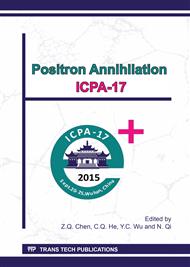p.104
p.108
p.113
p.117
p.122
p.126
p.130
p.134
p.138
Hydrogen-Induced Defects in Titanium
Abstract:
The aim of this work was investigation of hydrogen interaction with defects in Ti. Well-annealed Ti samples were loaded with hydrogen either electrochemically or using H2 gas phase. The hydrogen content and the phase composition of hydrogen loaded samples was determined by thermogravimetric analysis and by X-ray diffraction (XRD) respectively. Positron lifetime (LT) spectroscopy was employed for investigation of defects created by hydrogen loading. High-temperature H2 gas loading led to complete transformation of the whole sample into δ-TiH2 while low-temperature H2 gas loading and the electrochemical loading resulted in a non-uniform structure with most of the hydrogen absorbed in a sub-surface layer. All hydrogen-loaded samples exhibit positron lifetime component of ≈ 170 ps corresponding to positrons trapped at dislocations. Vacancy clusters were observed in the electrochemically loaded sample and the H2 gas phase loaded sample at low temperature.
Info:
Periodical:
Pages:
122-125
Citation:
Online since:
March 2017
Keywords:
Price:
Сopyright:
© 2016 Trans Tech Publications Ltd. All Rights Reserved
Share:
Citation:


